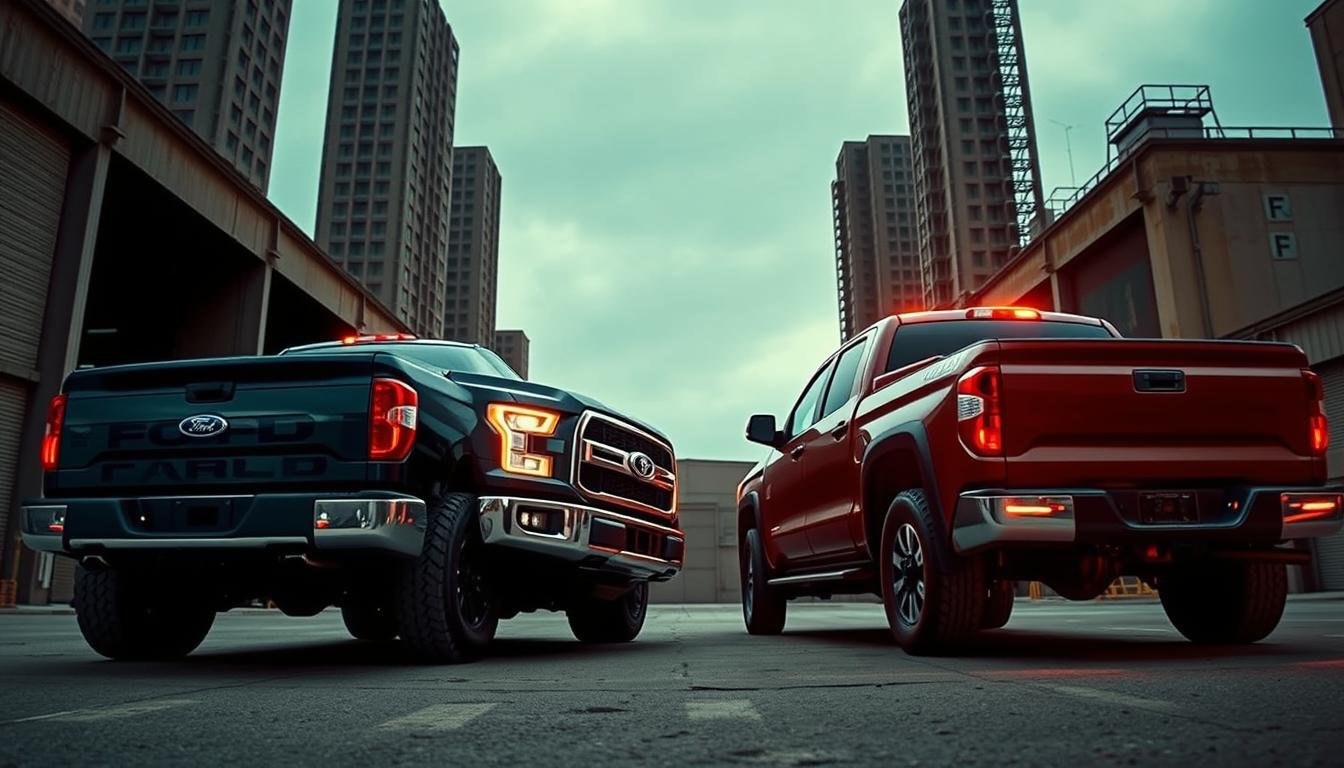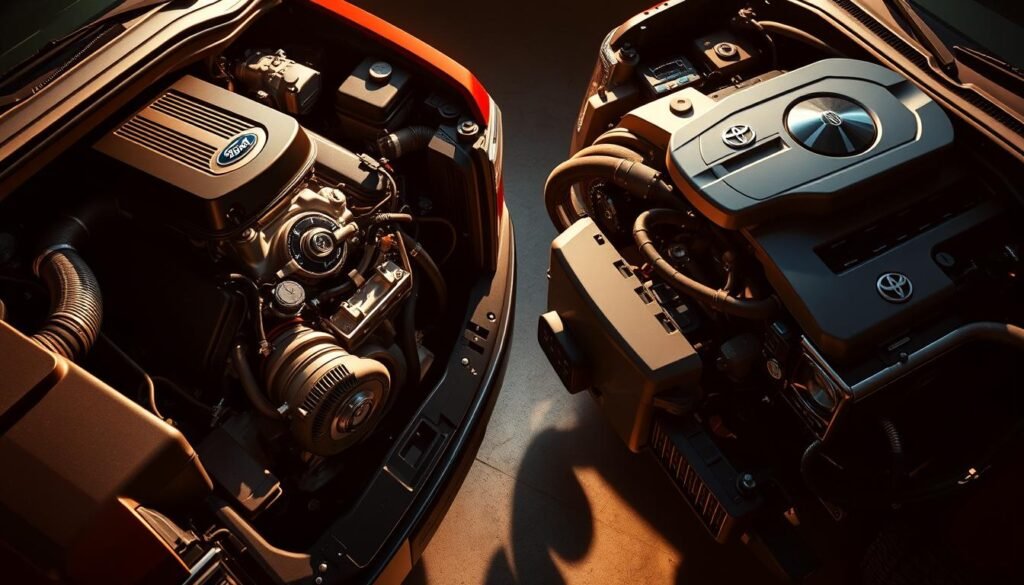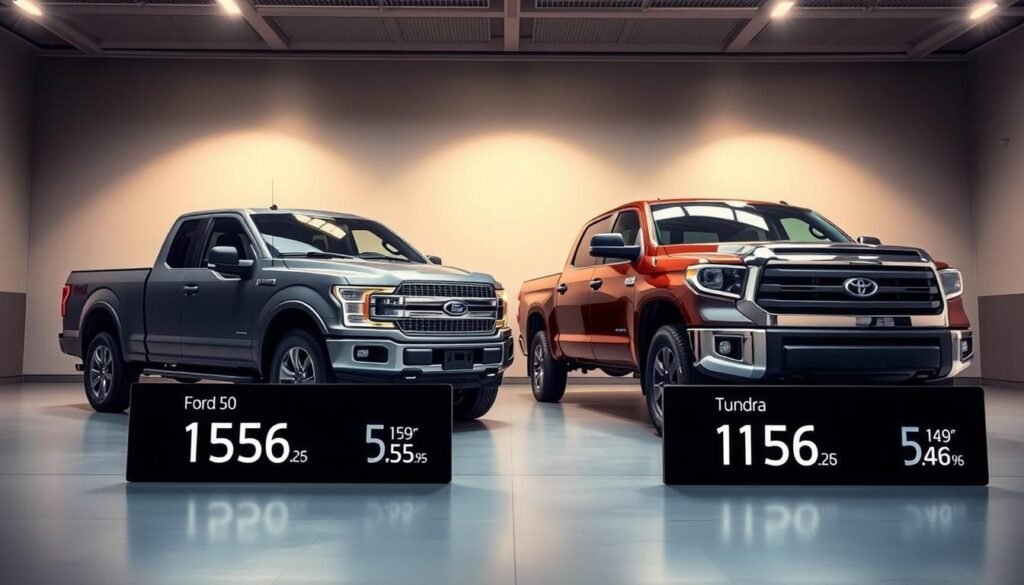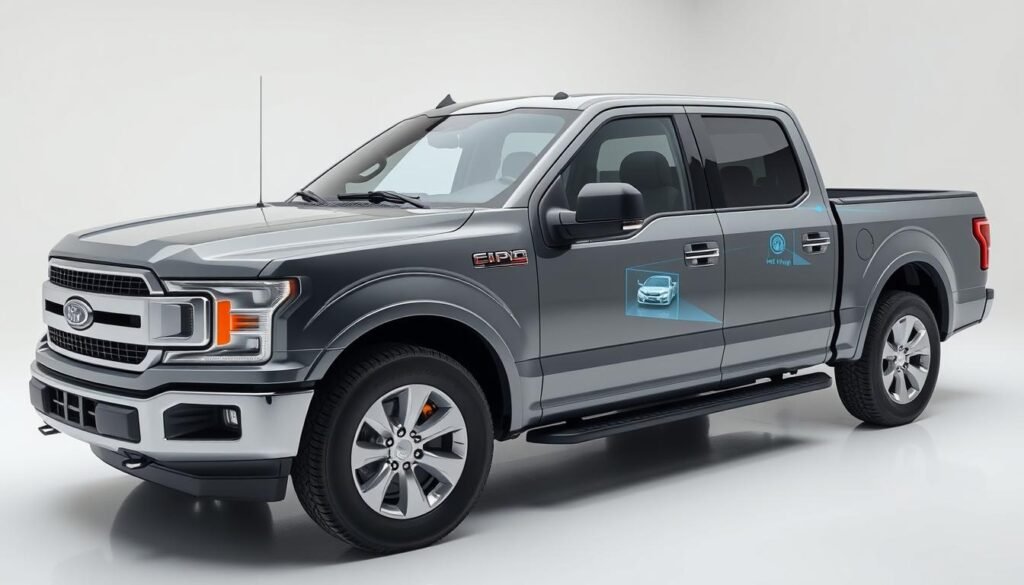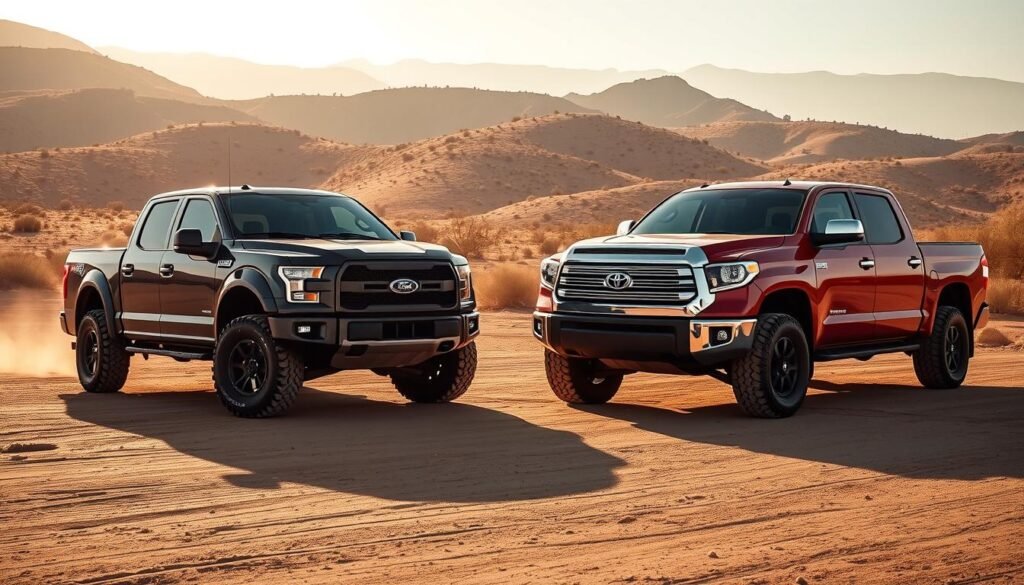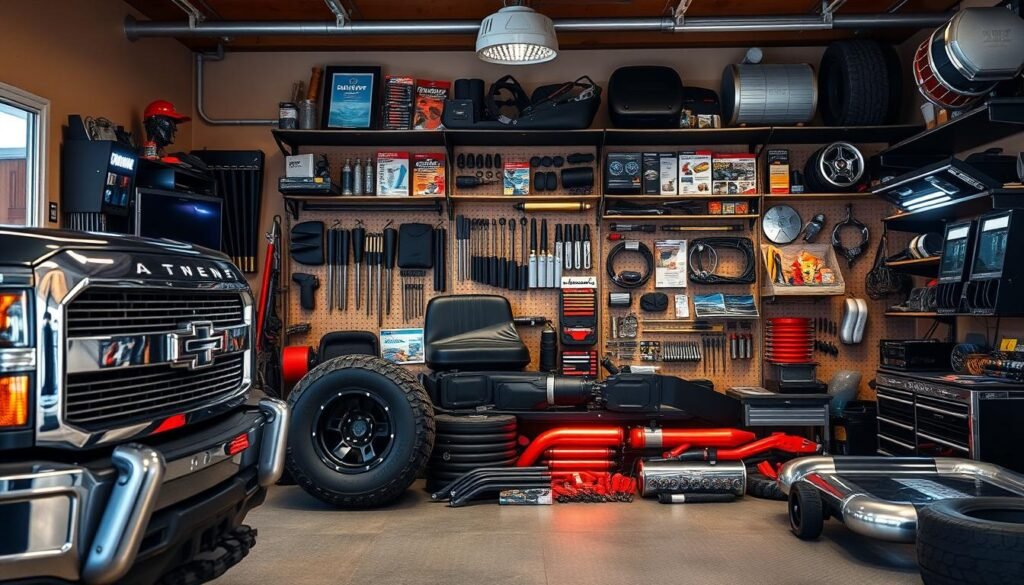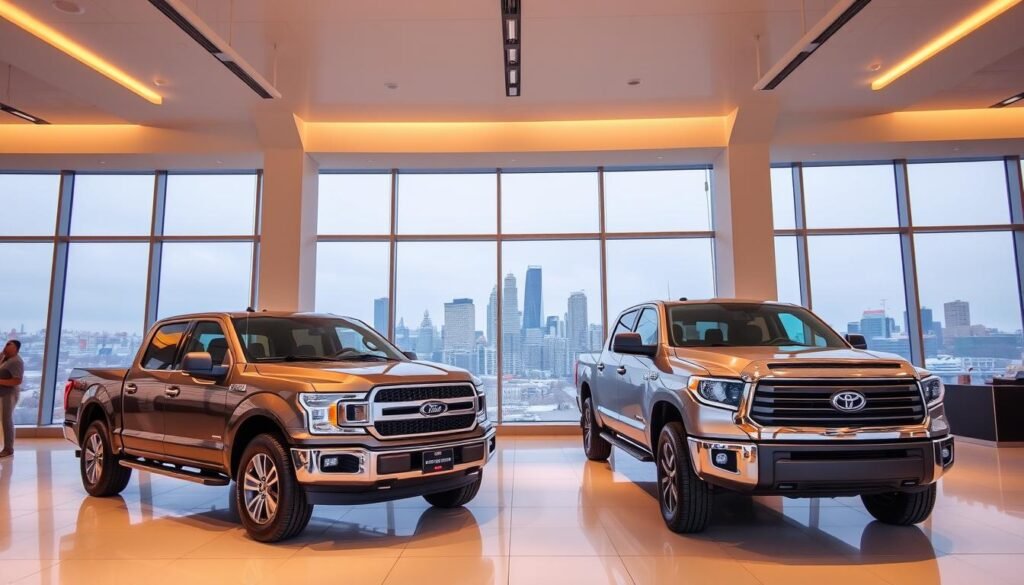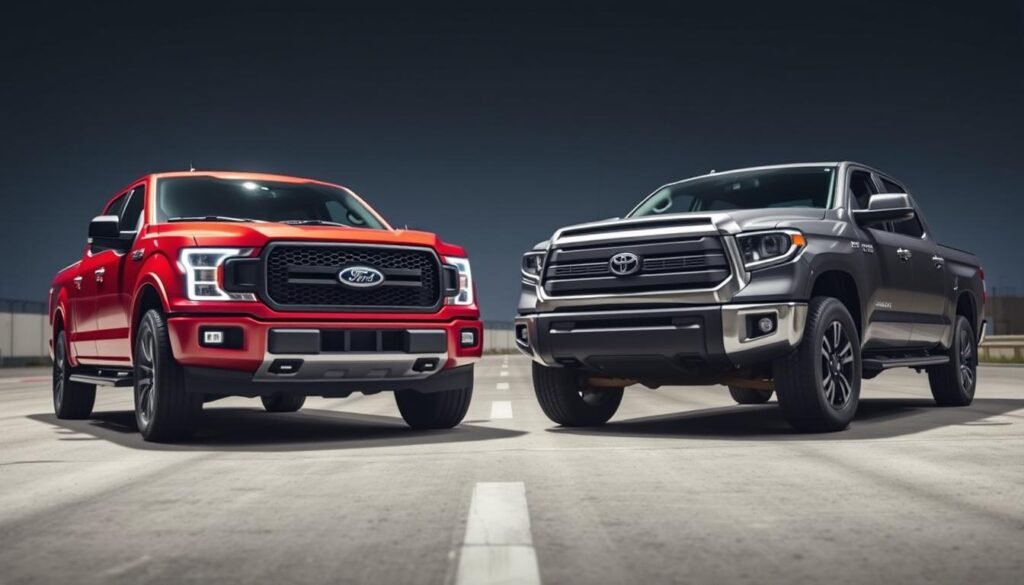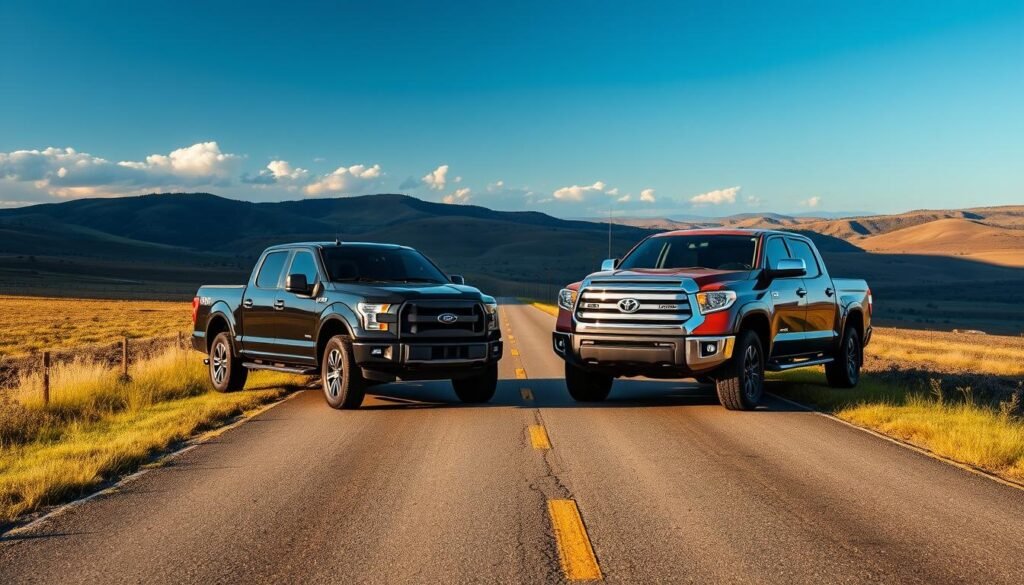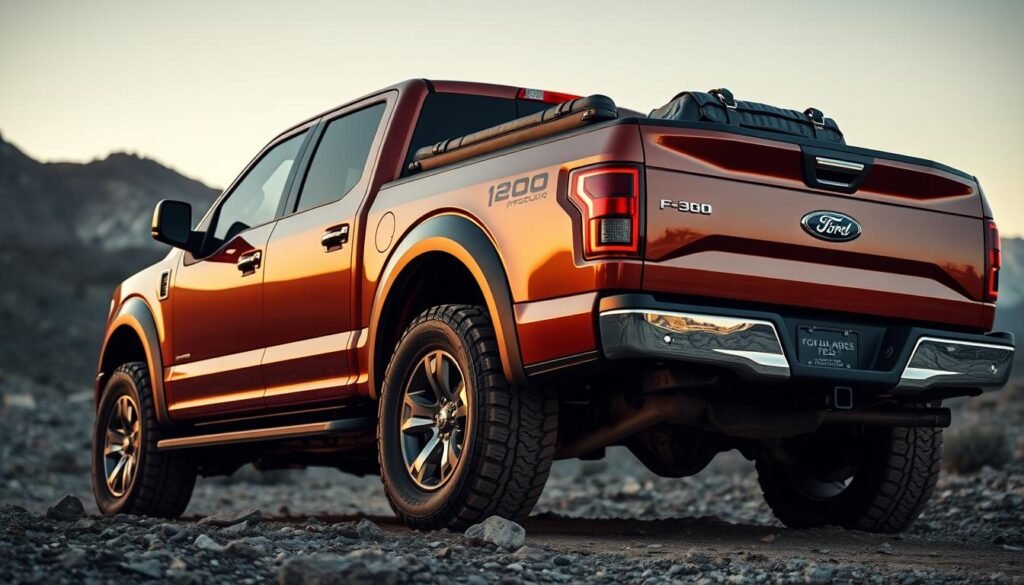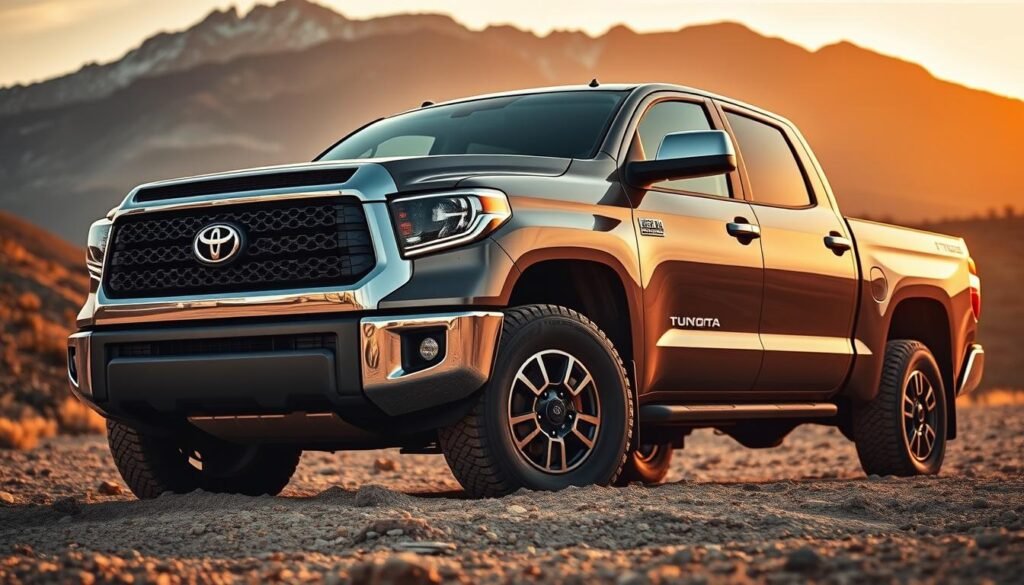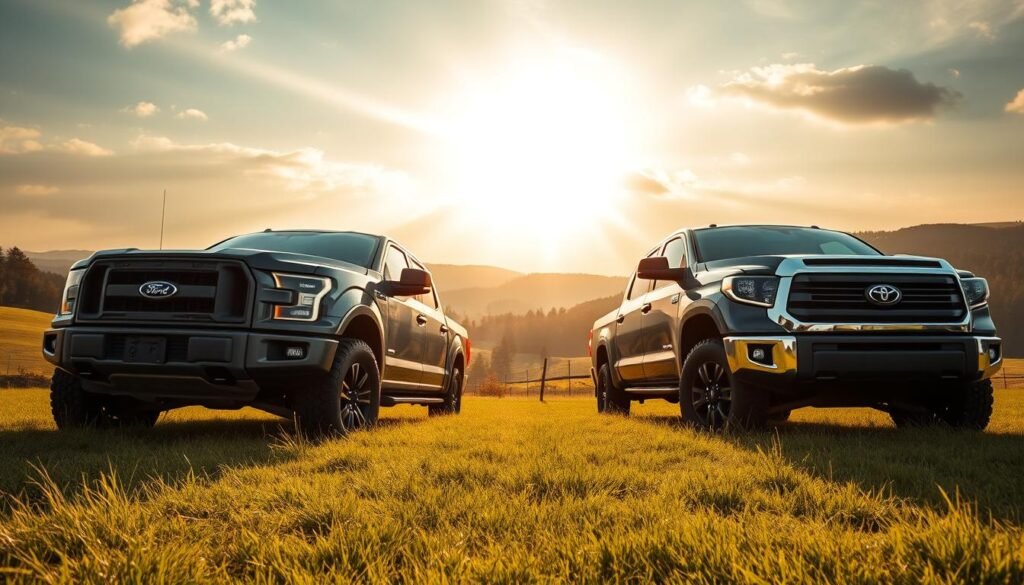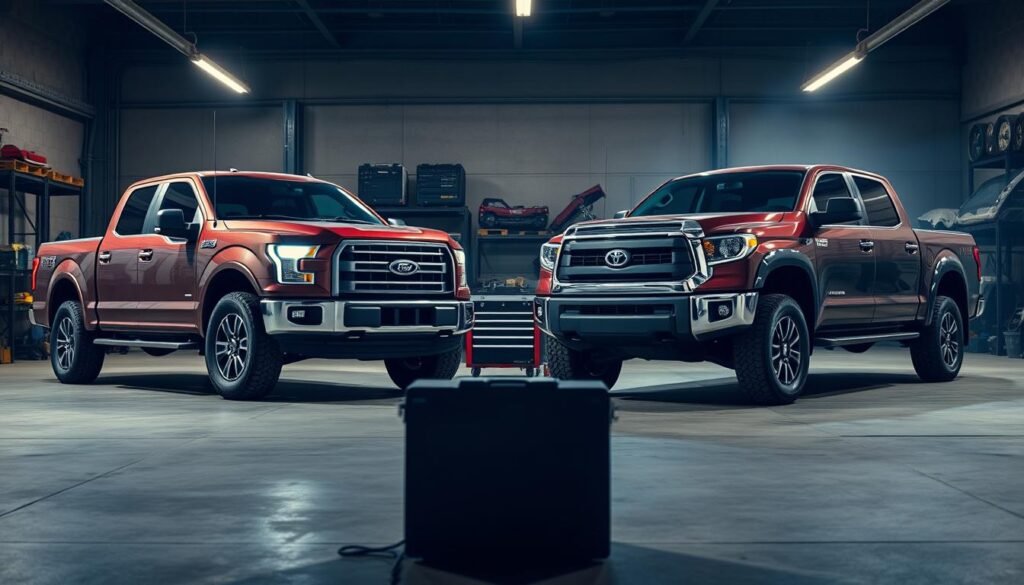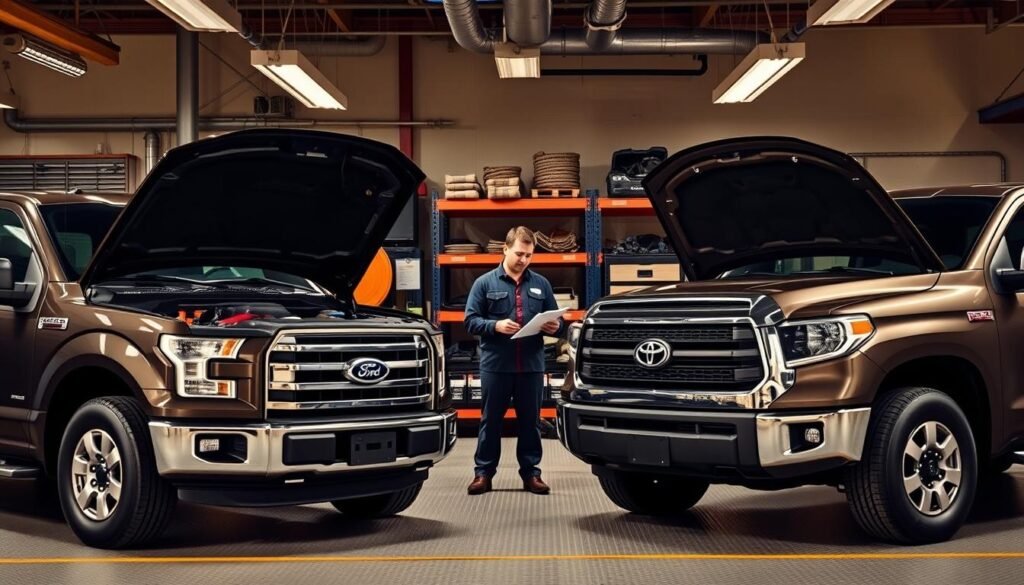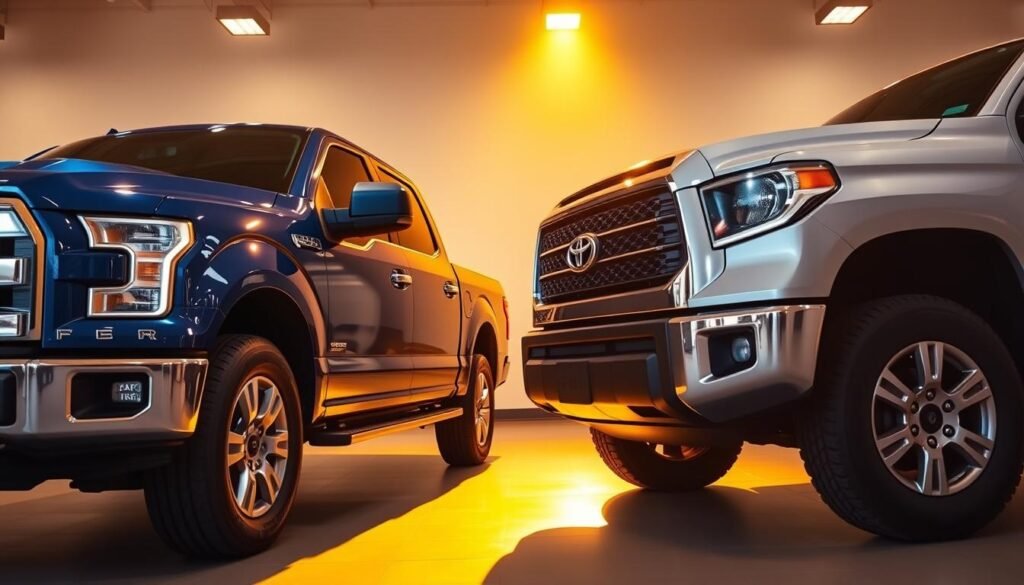In the world of pickup trucks, Ford F-150 and Toyota Tundra are at the top. They offer great performance, strong towing, and modern features. Whether you need a truck for fun or work, knowing the F-150 vs Tundra differences is key.
This guide will cover what makes Ford and Toyota trucks different. We’ll look at engine power, towing, fuel use, and more. By the end, you’ll know which truck is right for you, helping you make a smart choice.
Introduction
The Ford F-150 and Toyota Tundra are top choices in the full-size truck market. They each have their own set of features and abilities. If you’re looking to buy a truck, knowing how they compare is key.
Both trucks are known for their performance, durability, and versatility. This guide will dive into their engine power, towing abilities, and fuel efficiency. We’ll look at what makes each truck stand out.
When it comes to towing, both trucks are strong contenders. But, their specs can affect your choice based on your needs. This guide will help you understand the differences. It will give you insights on power, fuel economy, and technology.
Engine Performance and Choices
In the world of pickup trucks, the engine options are key. Let’s compare the Ford F-150 and Toyota Tundra.
Ford F-150 Powertrain Options
The Ford F-150 has many powertrain choices. The 3.5L EcoBoost V6 balances power and efficiency. The 5.0L Ti-VCT V8 offers raw power. The 3.3L Ti-VCT V6 is great for everyday use.
Ford also has hybrid models like the 3.5L PowerBoost Full Hybrid V6. It combines fuel efficiency with power. Every Ford F-150 engine comes with advanced tech for better hauling and driving.
Toyota Tundra Engine Lineup
The Toyota Tundra has fewer engines but they’re powerful. The 5.7L i-FORCE V8 and 4.6L V8 deliver strong horsepower and torque. This makes the Tundra reliable for heavy towing and tough terrains.
Toyota focuses on engine durability and reliability. The 5.7L i-FORCE V8 is known for its power and consistent performance under tough conditions.
Towing and Payload Capabilities
When looking at the towing and payload capabilities of the Ford F-150 and Toyota Tundra, it’s key to check their max specs. This helps figure out the best truck for different work needs and lifestyle choices. These specs are critical when hauling heavy equipment or towing recreational vehicles.
F-150 Towing and Hauling Specs
The Ford F-150 is known for its strong towing and payload capabilities. It can tow up to 14,000 pounds with the right setup. This makes it perfect for hauling heavy loads. Plus, it can carry up to 3,325 pounds in its bed.
Tundra Towing and Hauling Specs
The Toyota Tundra also has great towing and payload capabilities. It can tow up to 12,000 pounds, which is close to the F-150. The Tundra can carry up to 1,940 pounds, making it good for big loads too.
In short, the F-150 vs Tundra towing capacity shows each truck’s strengths. The Ford F-150 is great for heavy hauling. The Toyota Tundra is also strong, making it a good choice for many needs.
Fuel Efficiency Comparisons
When we look at the fuel efficiency of the Ford F-150 and Toyota Tundra, we must consider their engine options. Both brands have worked hard to make eco-friendly trucks. But how do they do in real-world fuel economy?
F-150 Fuel Economy
The Ford F-150 has many engine choices for different needs. It has strong V8s and more fuel-saving V6s. The 3.5L EcoBoost V6 is a top pick for those who want to save on fuel.
According to the EPA, this engine gets up to 20 MPG in the city and 26 MPG on the highway. This shows it’s great for cutting down on fuel costs.
Tundra Fuel Economy
The Toyota Tundra has a standard 5.7L V8 engine. It’s powerful but uses more fuel. The Tundra gets about 13 MPG in the city and 17 MPG on the highway.
While the Tundra performs well, its fuel use might be a drawback for those looking to save money and be eco-friendly.
In summary, the comparison shows the F-150 is better for those who want to save on fuel. It offers more eco-friendly and cost-effective options for a wider range of drivers.
Interior and Technology Features
Modern trucks like the Ford F-150 and Toyota Tundra offer top-notch interiors and tech. They come with features that make driving more comfortable and connected.
F-150 Interior Highlights
The Ford F-150 is known for its advanced tech and luxury cabin. It has the SYNC 4 infotainment system with a big touchscreen. This system connects easily with Apple CarPlay and Android Auto.
The F-150 also has a fold-down shift lever. This turns the center console into a flat workspace. It’s perfect for professionals on the move. The truck offers leather seats, optional massaging seats, and a large moonroof for a luxurious feel.
Tundra Interior Highlights
The Toyota Tundra has impressive interior features for comfort and convenience. It uses high-quality materials, including leather seats with heating and ventilation. The Tundra’s large infotainment screen supports Apple CarPlay and Android Auto.
The Tundra also has a big cabin, even in CrewMax models. It offers lots of legroom and storage. The truck has a premium audio system and advanced driver assistance tech. It’s all about making every drive better.
Safety Features and Driver Assistance
When looking at truck safety, the Ford F-150 and Toyota Tundra both have advanced tech. These features are designed to keep drivers and passengers safe. Knowing the safety ratings of each truck is key to making a smart choice.
The Ford F-150 comes with Ford Co-Pilot360. This system includes pre-collision assist, a rearview camera, and blind-spot info. These features help avoid accidents and boost driver confidence.
The Toyota Tundra has Toyota Safety Sense. It includes a pre-collision system, lane departure alert, and dynamic radar cruise control. These systems are critical in preventing accidents and keeping everyone safe on the road.
The table below compares the safety features of both trucks:
| Feature | Ford F-150 | Toyota Tundra |
|---|---|---|
| Pre-Collision System | Included | Included |
| Blind Spot System | Included | Included |
| Dynamic Cruise Control | Available | Included |
| Lane Keeping Assist | Available | Included |
Both trucks have a lot of safety features. Looking at the safety ratings and driver assistance tech helps you pick the right truck for your safety needs.
Off-Road Capabilities
In an off-road truck comparison, the Ford F-150 and Toyota Tundra shine. They come with special features for tough terrains. Knowing what each truck offers helps buyers make smart choices.
Ford F-150 Off-Road Options
The Ford F-150 has several off-road packages. The Tremor and Raptor are made for off-roading. They have advanced features:
- Suspension systems: The F-150 Raptor uses Fox Racing shocks for better off-road handling and a smoother ride.
- Ground clearance: It has up to 11.5 inches of ground clearance. This lets it clear obstacles easily.
- Off-road drive modes: It has a Terrain Management System. This includes modes like Mud/Sand, Baja, and Rock Crawl.
Toyota Tundra Off-Road Options
The Toyota Tundra is a strong competitor in the F-150 vs Tundra debate. Its TRD Pro package offers great off-road features:
- Suspension systems: The Tundra TRD Pro has Bilstein shocks and TRD-tuned springs. This makes it great on uneven surfaces.
- Ground clearance: It has 10.6 inches of ground clearance. This lets it handle tough trails.
- Off-road accessories: It comes with skid plates, tow hooks, and all-terrain tires. These features boost its off-road ability.
Both trucks prove their value in an off-road truck comparison. Whether you pick the F-150 or the Tundra, you get some of the best trucks for off-roading out there.
Configurations and Customization
Both the Ford F-150 and Toyota Tundra offer many customization options. They have different body styles and bed sizes. This makes them perfect for personal or commercial use, helping buyers find their ideal truck.
F-150 Body Styles and Bed Options
The Ford F-150 has a wide range of body styles and bed lengths. It comes in three cab styles: Regular, SuperCab, and SuperCrew. These styles meet different space needs.
- Regular Cab, ideal for basic, utilitarian needs.
- SuperCab, with extra seating and rear-hinged doors for better access.
- SuperCrew, providing ample passenger space with full-size rear doors.
Buyers can also choose from various bed lengths. Options range from a 5.5-foot bed for city driving to an 8-foot bed for more cargo space.
Tundra Cab and Bed Configurations
The Toyota Tundra has cab styles and bed sizes for different needs. It offers:
- Double Cab, balancing passenger room and cargo space.
- CrewMax, with extensive rear passenger space for long trips.
The Tundra also has three bed lengths. This allows for customization based on hauling needs. Choose from a 5.5-foot, 6.5-foot, or 8.1-foot bed to meet your needs.
| Customization Feature | Ford F-150 | Toyota Tundra |
|---|---|---|
| Cab Styles | Regular, SuperCab, SuperCrew | Double Cab, CrewMax |
| Bed Sizes | 5.5-foot, 6.5-foot, 8-foot | 5.5-foot, 6.5-foot, 8.1-foot |
Price and Value
When looking at the F-150 Tundra pricing, it’s key to compare base and fully-loaded models. The Ford F-150 and Toyota Tundra have many trims for different needs. This ensures buyers get the best cost-effective truck options with great value for money.
F-150 Pricing Overview
Ford’s F-150 starts with a good price, with basic models being affordable. Moving to higher trims adds more features and power, but keeps prices competitive. This range lets buyers choose a model that fits their budget, balancing cost and features.
| F-150 Model | Starting Price | Top-tier Price |
|---|---|---|
| XL | $28,940 | – |
| XLT | $35,050 | – |
| Lariat | $44,695 | – |
| King Ranch | $56,015 | – |
| Platinum | $59,805 | – |
| Limited | $73,105 | – |
Tundra Pricing Overview
The Toyota Tundra has a simpler but attractive pricing. It starts with a fair base price and goes up to luxury with premium trims. This ensures Toyota offers cost-effective truck options for all budgets, maximizing value for money.
| Tundra Model | Starting Price | Top-tier Price |
|---|---|---|
| SR | $35,950 | – |
| SR5 | $41,455 | – |
| Limited | $50,790 | – |
| Platinum | $59,490 | – |
| 1794 Edition | $60,310 | – |
| TRD Pro | $67,605 | – |
Both the F-150 and Tundra offer competitive prices, aiming to provide great value. By comparing these options, buyers can find the best value for money based on their needs and budget.
F-150 vs Tundra – Performance Comparison
The Ford F-150 and Toyota Tundra are top picks in the full-size pickup market. This comparison looks at their engines’ power and how they drive.
Power and Horsepower
Engine power is key in this showdown. The F-150 has several engine choices, including a 3.5-liter EcoBoost V6 that makes 450 horsepower. The Tundra, on the other hand, has a 5.7-liter i-FORCE V8 that hits 381 horsepower.
Even though the Tundra has less horsepower, the F-150 offers more options. This caters to both those who love speed and those who just need a reliable truck.
Torque and Transmission
Torque is also important in truck performance. The F-150’s best engines make up to 510 lb-ft of torque. The Tundra’s V8 reaches 401 lb-ft.
The F-150 also has a 10-speed automatic transmission. This setup is great for both speed and saving gas, making shifts smooth and efficient. The Tundra, with its 6-speed automatic, is good but not as efficient as the F-150.
These details show the differences in power and transmission. They highlight each truck’s unique qualities in the full-size pickup market.
Truck Buying Guide: Making the Right Choice
Choosing the right truck involves looking at several key factors. You need to decide between the Ford F-150 and the Toyota Tundra. This requires careful consideration of different aspects.
Factors to Consider
First, think about how you plan to use the truck. Will it be for heavy-duty tasks, towing, off-roading, or city driving? These are important things to think about.
Also, consider what features and technology you want. Both trucks offer different options to improve your driving experience.
Budget and Purpose
Another important factor is budgeting for a new truck. Setting a budget helps narrow down your choices. Think about the upfront cost and long-term expenses like fuel, maintenance, and resale value.
Matching your budget with your needs ensures you get the best value. This way, you make a smart investment.
By carefully evaluating these factors, you’ll be ready to choose the right truck. Whether it’s the Ford F-150 or the Toyota Tundra, you’ll find the perfect match for your needs and budget.
Ford F-150 Advantages
Choosing the Ford F-150 comes with many benefits. One major advantage is its wide range of engines. You can pick from a strong EcoBoost V6, a powerful V8, or even a hybrid. This makes it easy to find the perfect engine for your needs.
The F-150 also excels in towing. It has advanced features like an integrated trailer brake controller and Pro Trailer Backup Assist. These tools help make towing safer and more efficient.
The interior of the F-150 focuses on comfort and technology. It’s filled with high-quality materials and lots of storage. Plus, it has a user-friendly infotainment system with SYNC 4, which supports voice commands and connects to your smartphone.
In summary, the F-150 offers more than just great engines and towing tech. Its innovative interior and advanced safety features make it a top choice for many. It’s a well-rounded option for a wide range of consumers.
| Ford F-150 Benefits | Details |
|---|---|
| Diverse Engine Options | EcoBoost V6, V8, Hybrid |
| Advanced Towing Technologies | Pro Trailer Backup Assist, Integrated Trailer Brake Controller |
| Innovative Interior Design | High-quality materials, SYNC 4, ample storage |
Toyota Tundra Advantages
The Tundra strengths are clear, making it a top pick for many. It’s built tough, reliable, and safe. These qualities make it stand out.
The Tundra’s durability is unmatched. It can handle rough terrains and heavy workloads. This means it stays reliable even when things get tough.
Safety is a big deal for the Tundra. It comes with advanced systems like adaptive cruise control and automatic emergency braking. These features give drivers extra peace of mind.
If you want luxury and utility, the Tundra delivers. Its interior is filled with quality materials and the latest tech. This makes every drive better.
Talking about Toyota truck benefits, its resale value is key. The Tundra holds its value well, thanks to Toyota’s reputation for durability. This makes it a smart buy.
User Reviews and Testimonials
Many people looking at the Ford F-150 and Toyota Tundra check out what current owners say. Customer feedback is key to knowing how these trucks perform in real life. It gives valuable insights to those thinking of buying one.
F-150 User Insights
Ford F-150 owners love its strong performance and modern tech. They often talk about its great towing and smooth ride, even when loaded. Fuel efficiency and interior quality are also big pluses.
But, some have had problems with the truck’s electronics over time. Despite this, the F-150 gets mostly good reviews. People praise its versatility and reliability in different driving situations.
Tundra User Insights
Toyota Tundra owners rave about its reliability and toughness. They say the truck’s engine is powerful and the cabin is roomy. Many have owned their Tundra for over 10 years without major issues.
Some mention the truck drinks more fuel than others. Yet, most Tundra owners are very happy with its build and dependability.
Warranty and Reliability
When looking at truck warranties, like those for the F-150 and Tundra, it’s key to understand the coverage and reliability. Both Ford and Toyota offer long warranties to give truck owners peace of mind. But, the details can differ and affect how happy owners are in the long run.
Ford F-150 Reliability
The Ford F-150 is known for its great warranties. It has a 3-year/36,000-mile bumper-to-bumper warranty and a 5-year/60,000-mile powertrain warranty. These warranties cover common problems and big repairs for a certain time. Ford’s focus on quality makes the F-150 a top choice for dependable trucks.
The F-150 is also known for being reliable. It gets high marks from J.D. Power and Consumer Reports for reliability. This makes it a great pick for those wanting a truck that lasts a long time.
Toyota Tundra Reliability
The Toyota Tundra is also known for its reliability and good warranties. It has a 3-year/36,000-mile basic warranty and a 5-year/60,000-mile powertrain warranty, just like Ford. This coverage helps keep owners happy by protecting against unexpected repair costs.
In the debate of F-150 vs Tundra longevity, the Tundra is known for being very dependable. Owners often say they’re very happy with how long it lasts and how well it performs. Both J.D. Power and Consumer Reports say the Tundra is very reliable, making it a strong competitor in the pickup market.
Maintenance and Ownership Costs
When looking at the F-150 vs Tundra, it’s key to think about repairs, service times, and part availability. The cost of owning a truck affects long-term happiness and budgeting.
The *Ford F-150* needs regular oil changes, tire rotations, and brake checks every 5,000 to 7,500 miles. Owners will spend on routine services and parts, with costs changing based on use and conditions. Costs include brake pad replacements, battery checks, and air filter changes. The Ford F-150 has widely available parts and competitive service prices, keeping maintenance costs reasonable.
The Toyota Tundra also needs regular maintenance, like oil changes and tire rotations. *Tundra* owners should plan for standard service and repairs, like brake pad changes and battery replacements. *Toyota Tundra* parts are usually easy to find, but availability can differ by area, affecting upkeep costs.
Comparing the cost of owning a truck, the Ford F-150 and Toyota Tundra have similar maintenance needs. But, part prices and labor rates can vary, leading to cost differences. Here’s a comparison of typical annual upkeep costs for both trucks:
| Maintenance Item | Ford F-150 | Toyota Tundra |
|---|---|---|
| Oil Change | $40 – $70 | $50 – $80 |
| Brake Pad Replacement | $150 – $300 | $200 – $350 |
| Tire Rotation | $20 – $50 | $25 – $60 |
| Battery Replacement | $100 – $200 | $120 – $220 |
| Air Filter Change | $30 – $60 | $35 – $70 |
In conclusion, knowing the maintenance and ownership costs for the F-150 and Tundra is vital. Regular maintenance and repair costs are key to owning a truck. Both trucks have similar maintenance needs. Planning for these costs ensures a well-maintained vehicle with fewer surprises.
Resale Value Comparison
When looking at truck resale values, the Ford F-150 and Toyota Tundra both offer great returns. But, their market performance can change based on different factors. Knowing the resale profitability of these trucks can help you make a smart investment choice.
F-150 Resale Insights
The Ford F-150 has always had strong resale values. This is thanks to Ford’s reputation for being durable and reliable. Several things affect its resale value, including:
- Brand loyalty among Ford owners
- Extensive dealer network ensuring easy maintenance and part availability
- Versatile configurations catering to a broad range of buyer needs
Also, Ford’s ongoing innovation in technology and performance keeps demand high in the used truck market. This boosts the resale profitability of the F-150.
Tundra Resale Insights
The Toyota Tundra also has impressive truck resale values. This is thanks to Toyota’s known reliability and long-term dependability. Key factors that contribute to its strong resale value include:
- High quality build and robust design
- Exceptional longevity and low annual maintenance costs
- Strong market perception as a durable and reliable workhorse
The Tundra’s lasting performance and reputation for needing few repairs make it appealing in the pre-owned market. This ensures a profitable investment.
When comparing the F-150 vs Tundra investment, think about each truck’s strengths and market reputation. This knowledge helps you pick the truck that fits your long-term financial and utility goals.
Conclusion
The F-150 vs Tundra verdict shows both trucks have their strengths. The Ford F-150 shines with its power, towing, and tech. It’s perfect for those who want a truck that can do it all. Plus, it’s good on gas and comfy inside.
The Toyota Tundra, on the other hand, is known for its reliability and off-road skills. It’s simple yet tough, making it great for those who value ruggedness. It also has top-notch safety and lasts a long time, which is key for long-term use.
So, which truck is best for you? It really depends on what you need. If you want the latest tech and good fuel economy, go for the F-150. But if you’re all about reliability and off-road adventures, the Tundra is your friend. This summary helps you choose the right truck for your life and driving habits.
FAQ
What are the engine options available for the Ford F-150?
The Ford F-150 has many engine choices. You can pick from a 3.3L V6, 2.7L EcoBoost V6, 3.5L EcoBoost V6, 5.0L V8, or a 3.5L PowerBoost Full Hybrid V6. Each engine has its own horsepower and torque, meeting different needs.
How does the Toyota Tundra’s engine lineup compare to the Ford F-150’s?
The Toyota Tundra has fewer engine options but is very robust. It mainly has a 5.7L V8 engine, known for its durability and power. This makes it a strong competitor to the F-150 in terms of performance and reliability.
Which truck has better towing capabilities, the F-150 or the Tundra?
The Ford F-150 can tow more, up to 14,000 pounds, depending on the setup. The Toyota Tundra can tow up to 10,200 pounds. This difference is key for those who need to tow a lot.
Which truck is more fuel-efficient?
The Ford F-150 is more fuel-efficient, thanks to its hybrid PowerBoost model. The Toyota Tundra, with its larger V8 engine, uses more fuel. Fuel efficiency is important for saving money and being eco-friendly.
What are the key interior and technological features of the Ford F-150 and Toyota Tundra?
The Ford F-150 has cool features like a fold-down shift lever and advanced infotainment systems with SYNC 4. The Toyota Tundra focuses on luxury with comfortable seats and tech like a big touchscreen and navigation. Both trucks offer a high-tech, comfortable ride.
Are safety features and driver assistance technologies better in the F-150 or the Tundra?
Both trucks have advanced safety features. The F-150 has Ford Co-Pilot360 technology, with features like automated emergency braking. The Tundra has Toyota Safety Sense, with similar safety features. These features are important for safety on the road.
How do the off-road capabilities of the F-150 and Tundra compare?
The Ford F-150 has off-road packages like the FX4 and the Raptor for serious off-roading. The Toyota Tundra has the TRD Pro package for off-roading, with enhanced suspension and all-terrain tires. Both trucks are great for off-roading, but the right choice depends on your needs.
What body styles and customization options are available for each truck?
The Ford F-150 comes in Regular Cab, SuperCab, and SuperCrew, with various bed lengths. The Toyota Tundra has Double Cab and CrewMax cab styles with different bed sizes. Both trucks offer many customization options to fit your needs.
How do the prices of the F-150 and Tundra compare?
The Ford F-150 has a wide price range, from basic to luxurious. The Toyota Tundra also has a wide range but starts at a slightly higher price due to its V8 engine. Price is important when deciding which truck to buy.
What are the key differences in performance between the F-150 and Tundra?
The Ford F-150 offers multiple powertrain options, including the PowerBoost hybrid. The Toyota Tundra focuses on a powerful V8. The F-150 gives more customization in performance, while the Tundra is robust and reliable.
What should I consider when choosing between the F-150 and Tundra?
Think about your main use (towing, off-roading, daily driving), budget, and the truck’s long-term value. These factors will help you choose the right truck for you.
What are the specific advantages of choosing the Ford F-150?
The Ford F-150 has a wide range of engines, advanced towing tech, and innovative features like a fold-down shift lever. It appeals to many, from performance lovers to those seeking modern features.
What are the unique selling points of the Toyota Tundra?
The Toyota Tundra is known for its strong build, reliability, and focus on safety and luxury. It has features like the TRD Pro off-road package and a powerful V8 engine. It’s a top choice for those seeking durability and comfort.
What do user reviews and testimonials reveal about the F-150 and Tundra?
Reviews show the Ford F-150’s versatility and advanced features. Toyota Tundra owners praise its reliability and strong performance. Both trucks have loyal fans, with different strengths and preferences.
How do the warranty offerings and reported reliability statistics compare between the F-150 and Tundra?
The Ford F-150 has a good warranty package, but the Toyota Tundra is known for long-term reliability. Warranty and reliability are important for peace of mind and long-term costs.
What are the typical maintenance and ownership costs associated with these trucks?
Both trucks have similar maintenance costs, but the Tundra’s single engine might be easier to maintain. Comparing maintenance schedules, repair frequency, and parts availability helps understand total ownership costs.
Which truck has a better resale value?
Historically, Toyota Tundras hold their value better due to their reliability. But the Ford F-150 also has high resale values, thanks to popular models and features. Resale value is key for long-term investment.

